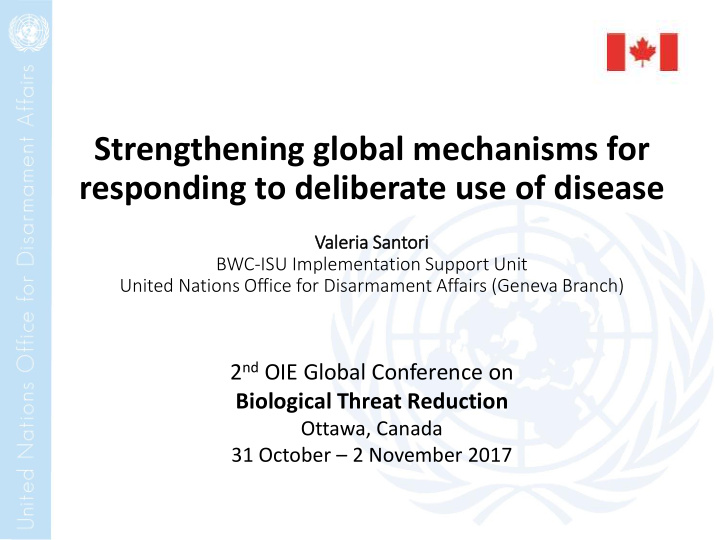



Strengthening global mechanisms for responding to deliberate use of disease Vale leria ia Santori BWC-ISU Implementation Support Unit United Nations Office for Disarmament Affairs (Geneva Branch) 2 nd OIE Global Conference on Biological Threat Reduction Ottawa, Canada 31 October – 2 November 2017
Project Background & Trigger • Ebola Virus Disease Outbreak 2014/2015 • Major gaps at int’l level highlighted • Potentially dramatic consequences that could be caused by a deliberate release scenario • Eighth Review Conference • Several proposals on Art. VII, none materialized • Progress on Art VII/Final Declaration • WG/G7 Global Partnership Mtg., 22-24/02/17 Rome Italy • Preparation of ‘Art. VII project’ proposal • Project funded by Canada through its Global Partnership Programme • Close cooperation on TTXs with Georgetown University/Talus Analytics
Art VII/BWC “Each State Party to this Convention undertakes to provide or support assistance, in accordance with the United Nations Charter, to any Party to the Convention which so requests, if the Security Council decides that such Party has been exposed to danger as a result of violation of the Convention. ” To deter use of BW by reducing its effectiveness, thereby providing a further disincentive to contravention of the BWC To express solidarity/part of the normative framework against BWs Understanding that assistance humanitarian in nature Obligation only applies if two conditions are fulfilled: • Security Council Decision • SP Request for Assistance
Add. Understandings and Agreements reached at Review Conferences The UN and other IOs could also play an important role in coordinating , mobilizing and delivering the required support and assistance . In this respect, the capacities and experiences of UN and relevant IOs should be identified and used , within their mandates, when required and upon request of the concerned State Party.” (VIII.VII.39) The UN could play a coordinating role in providing assistance , with the help of States Parties as well as the appropriate IGOs such as the WHO, OIE, FAO, and IPPC . (VII.VII.36) ... the need for a procedure for assistance by which timely emergency assistance can be provided… (VIII.VII.38)
Some Key Limitations & Challenges • Lack of operationalization : all phases, from invoking Art VII up to on-site coordination issues • How does a SP trigger Art VII? Interaction with UNSC • Need to understand the demands of implementing Article VII in all its stages • Is prior determination of deliberate disease a prerequisite for invoking Article VII and UNSC action? • “ Exposed to danger …” What does it encompass? • What assistance? • Timely emergency assistance even before a Security Council decision • Nature of assistance: humanitarian • Need to clarify the additional benefits to States Parties for invoking Article VII over existing mechanisms …
Overarching Project Objectives Strengthening global mechanisms and capabilities for responding to the deliberate use of disease • Strengthened response preparedness through effective policy coordination and resource sharing among relevant international organizations; • Strengthened international coordination capabilities at the operational level in the event of a BW attack; and • Availability of operational procedures and tools under the BWC at the disposal of BWC States Parties.
Difference that the ISU Project makes… Deliverables Phase I (end of March 2018) Preparation of a comprehensive feasibility study with the following outputs: 1. Comprehensive report about challenges potentially to be faced by the UN and relevant IOs in responding to a deliberate release of bio-agents with particular consideration of the situation under the BWC 2. Key processes of investigation and assistance delivery and coordination scenarios mapped out 3. Roles and responsibilities of the main stakeholders identified 4. First draft of a Bio-Emergency Management Plan (non-legally binding document) developed Development of Capabilities under the BWC while strengthening global mechanisms
Project Implementation Principles • Phased Project Approach • Phase I: Feasibility Study • Phase II: Operationalizing Recommendations • Build upon work already undertaken (CTITF, UNIDIR-FRS, Wilton Park, UNSGM, UNMEER, etc.) • Engage with relevant IOs (e.g. WHO, OIE, FAO, OPCW, OCHA, IASC) and UN Secretariat entities • Develop synergies with ongoing activities of relevant IOs and initiatives from States Parties • Take into consideration proposals made by BWC States Parties during the last ISP 2012-2015, incl. Eighth Review Conference Methods • Desk Research // Interviews // TTXs // Participation in Activities
Table-Top Exercise, 9-10 Oct, Geneva Objectives: • Provide input to the project’s key deliverables by • Identifying challenges, constraints and resource deficits • Mapping key processes for a coordinated int’l response • Identifying roles, responsibilities, mandates and capacities (including resources) of the main actors Participants: • ICRC, INTERPOL, IPI, OIE, OPCW, OCT/UNCCT, UNDSS, IASC, UNOCHA and WHO
TTX Scenario, Focus and Methodology TTX Focus • Single, relatively simple scenario • Three focus areas: (i) Initial Triggers (ii) International Response and Coordination (iii) Policy Actions Methodology • “Soft” exercise setting • Interactive discussions • Initially natural, then confirmed deliberate outbreak
Some of the Issues discussed and the way ahead • Info sharing • Triggering Article VII: • First draft model/flow chart developed – various options at hand for a SP • Impact of Art VII invocation and UNSC involvement • Discussion on challenges and obstacles • Value of a ‘coordination mechanism/Inter Agency Committee’ • Providing guidance re. response framework required • Need for reflection re. involvement of SPs in the process
Bio-Emergency Management Plan for Deliberate Events (BEMPD) Model: IAEA J-Plan Preliminary Structure • Purpose and Objectives • Guiding Principles for Response • Description of Emergency Phases • CONOPS • Article VII Process • App A: Legal instruments • App B: Authorities, responsibilities and capabilities of Orgs • App C: Glossary and Abbreviations Issues to be considered Consider more formalized ‘Inter - Agency Committee’ to prepare Bio-Emergency Plan in the advanced drafting stage Need to address question of feeding draft into formal BWC Process
For more information … ww www. w.un unog og.ch/b .ch/bwc wc Or contact: BWC Implementation Support Unit United Nations Office for Disarmament Affairs Palais des Nations Geneva fax: +41 (0)22 917 0483 e-mail: bwc@unog.ch @BWCISU www.facebook.com/1972BWC
Recommend
More recommend